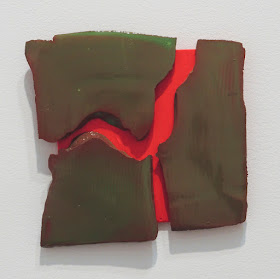"The sun has changed position.
No going back.
But the canvas remains warm."
A man wanders, as in a dream, through landscapes, towns, cities; he meets a monk, and a man in a roadside diner who needs to speak of his philosophy of life. Finally, he arrives at a building full of paintings, paintings that he describes as though they are real life: of a landscape he says: "If I just enter here, I will never come back". The Russian director Alexander Sokurov's Elegy of a Voyage, 2001, which you can watch online here, is a reverie, as this unknown man, mainly hidden from view, tries to find his place in the world. He finally discovers it within paintings, remembering himself to be at the site of the Pieter Saenredam painting shown above, there when it was painted, where he knew the people, the window, the light. Sokurov, who was the director of the brilliant Russian Ark, has a remarkable approach to paintings; I've never seen any depiction of them which brings them so close to actual life. For him, a painting is the same as a film; they are as real as each other, and as much of an illusion.
In an interview on the dvd containing two short films, Elegy of a Voyage, and Hubert Robert, A Fortunate Life (1996), Sokurov discusses the connection between painting and cinema: they are both flat:
....therefore all the talk of the third dimension in film is a game and a mistake. I think that one must do his utmost to achieve the same results artists manage to obtain while creating a painting.
A flat image has something. Something that we hold back from the viewer. A reticence. And art is only where this reticence exists. A limitation of what we can actually see and feel.I find this analysis of the heart of painting's magical nature fascinating. I've long felt that one of the things that is most compelling to me about doing my own paintings is creating an illusion of tangible reality; that the painting is actually flat makes this an uncanny process. Sokurov very emphatically state that he has no interest at all in 20th century art; for him, the greatest art was made during the 17th, 18th, and 19th centuries. But I think that the idea of reticence also applies to 20th century abstraction, to all painting really. It all holds something back; it all asks us to think, to imagine, to feel. And what about realist sculpture? I wonder what Sokurov would say about that. Does providing a lot of information in a three dimensional work negate reticence, and therefore mystery? I would think it's a different kind of mystery: one that wonders how wood, clay, stone, can be transformed into an object that pulses with life, such as this ancient Egyptian portrait head of Senwosret III:
There has to be a mystery, and the flat image provides this mystery.
Is art "only where this reticence exists"? In the sense that artists are not gods, are not creating "reality"––though reality itself is something to argue about––yes. Yes, something is held back, and in that is art's mystery.













































